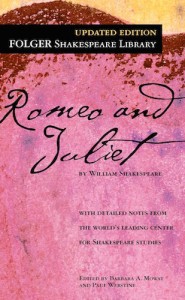Off The Bookshelf: Romeo & Juliet/West Side Story
I know it’s been a while since I’ve shared a book on my Off The Bookshelf segment, so this week, I’m going to discuss one of my favorites. I’ve talked about this famous story in depth a few times before, notably to discuss five points that are often missed and the reasons why it’s a greater story than many people think. Once again, I’d like to revisit this classic tale of forbidden love, this time in a double dose. I hope you’ll enjoy this review of one of my favorite books off my shelf: Romeo & Juliet/West Side Story.
Summary
First published in 1965, Romeo & Juliet/West Side Story comprises two stories in one: the stage play Romeo & Juliet by William Shakespeare; and the 1957 Broadway musical West Side Story by Arthur Laurents. The book also includes explanatory notes for unfamiliar expressions in Shakespeare’s play and a foreword by renowned theater director Norris Houghton.
Romeo & Juliet tells the story of two teenagers in Renaissance Verona who fall in love despite the age-old feud between their families, but who are driven to an untimely end by fate and the violent circumstances surrounding them. Inspired by Shakespeare’s play, West Side Story tells the same tragic tale of a doomed romance between young lovers, but updates the setting to modern-day New York and the protagonists to a white American boy and a Puerto-Rican girl torn apart by the racism-fueled rivalry between the street gangs with which they’re associated. As much for Romeo and Juliet as for Tony and Maria, love blossoms at first sight and against the odds, only to be threatened and destroyed by hatred that brings tragedy not just to the young lovers, but to their war-torn society as a whole.
Review
 I first read this book as a teenager, shortly after watching the 1961 movie West Side Story as homework for singing lessons (I was to sing “Somewhere” at my first presentation). Long familiar with the plot of the original play, I had fallen in love with the story of forbidden romance and was eager to finally read Shakespeare’s timeless classic for myself. Of course, I’ve made my love for the story itself abundantly clear in the past, so this review will focus a little more on the format of this book than on the pieces within it.
I first read this book as a teenager, shortly after watching the 1961 movie West Side Story as homework for singing lessons (I was to sing “Somewhere” at my first presentation). Long familiar with the plot of the original play, I had fallen in love with the story of forbidden romance and was eager to finally read Shakespeare’s timeless classic for myself. Of course, I’ve made my love for the story itself abundantly clear in the past, so this review will focus a little more on the format of this book than on the pieces within it.
What I find most interesting about this particular book is the way the same story is presented over two very different backdrops: one in Renaissance Italy, the other in 1950s New York. By combining both stories into one volume, Romeo & Juliet/West Side Story offers a unique way to visualize the tale of star-crossed young love across time. The similarities and differences between these popular pieces become clearer as the reader is able to quickly swap a scene in one play for its parallel in the other: the feud between the Montagues and the Capulets becomes a turf war between the Jets and the Sharks, the Capulet ball becomes the dance at the gym, the poetic exchange at Juliet’s balcony becomes a duet on Maria’s fire escape. Each story is beautiful in its own right, but I’ve found that to be able to compare and contrast them so easily makes the fundamental plot all the more fascinating.
 Romeo & Juliet was the first Shakespearean play I ever read, so naturally I was yet unfamiliar with Elizabethan English. This is where the notes in the back of the book came in extremely handy. Essential words and terms are referenced to the line with modern English translations and explanations wherever necessary, so the notes were a tremendous help when it came to deciphering the meanings within Shakespeare’s verse. It’s worth noting that they’re still helpful to any new reader who plans to read more of Shakespeare, as several of the expressions used in Romeo & Juliet commonly appear in his other works. Unfortunately, a similar device isn’t available for West Side Story, which relies on its readers’ familiarity with the music to be fully enjoyable, but this is merely a minor drawback to what is otherwise an equally stunning theatrical masterpiece.
Romeo & Juliet was the first Shakespearean play I ever read, so naturally I was yet unfamiliar with Elizabethan English. This is where the notes in the back of the book came in extremely handy. Essential words and terms are referenced to the line with modern English translations and explanations wherever necessary, so the notes were a tremendous help when it came to deciphering the meanings within Shakespeare’s verse. It’s worth noting that they’re still helpful to any new reader who plans to read more of Shakespeare, as several of the expressions used in Romeo & Juliet commonly appear in his other works. Unfortunately, a similar device isn’t available for West Side Story, which relies on its readers’ familiarity with the music to be fully enjoyable, but this is merely a minor drawback to what is otherwise an equally stunning theatrical masterpiece.
Both Romeo & Juliet and West Side Story have had a profound impact on audiences: one for its poetic deconstruction of romantic ideals, the other for its dramatic commentary on the consequences of social intolerance. The presentation of both plays in one volume brings to light the true timelessness of Shakespeare’s classic, proving that the story of love born against hate will be forever relevant as long as people and society continue to be powerfully motivated by both.
Inspiration
Romeo & Juliet is the archetype of forbidden love thwarted by circumstance, so it’s no wonder the story has translated so well into the modern setting of West Side Story. Whether set between feuding families or warring street gangs, this tragic love story reads not only as the epitome of the passion and dangers of young romance, but as a lesson on how hatred kills. Perhaps for its universal themes of love, intolerance, and the cruelty of fate, the plight of the star-crossed lovers is a tale that has fascinated readers for centuries and certainly will for many more to come. It has served as inspiration for much of my romantic fiction, and to this day I indulge in it whenever I feel the need to satisfy my cravings for drama and romance.
For all the above reasons and more, Romeo & Juliet is and likely always will be my favorite story at its core, regardless of the characters, settings, and details that flesh it out. To be able to enjoy my two favorite versions of the story in a single volume is simply the cherry on top of a classic poetic delight.



Recent Comments